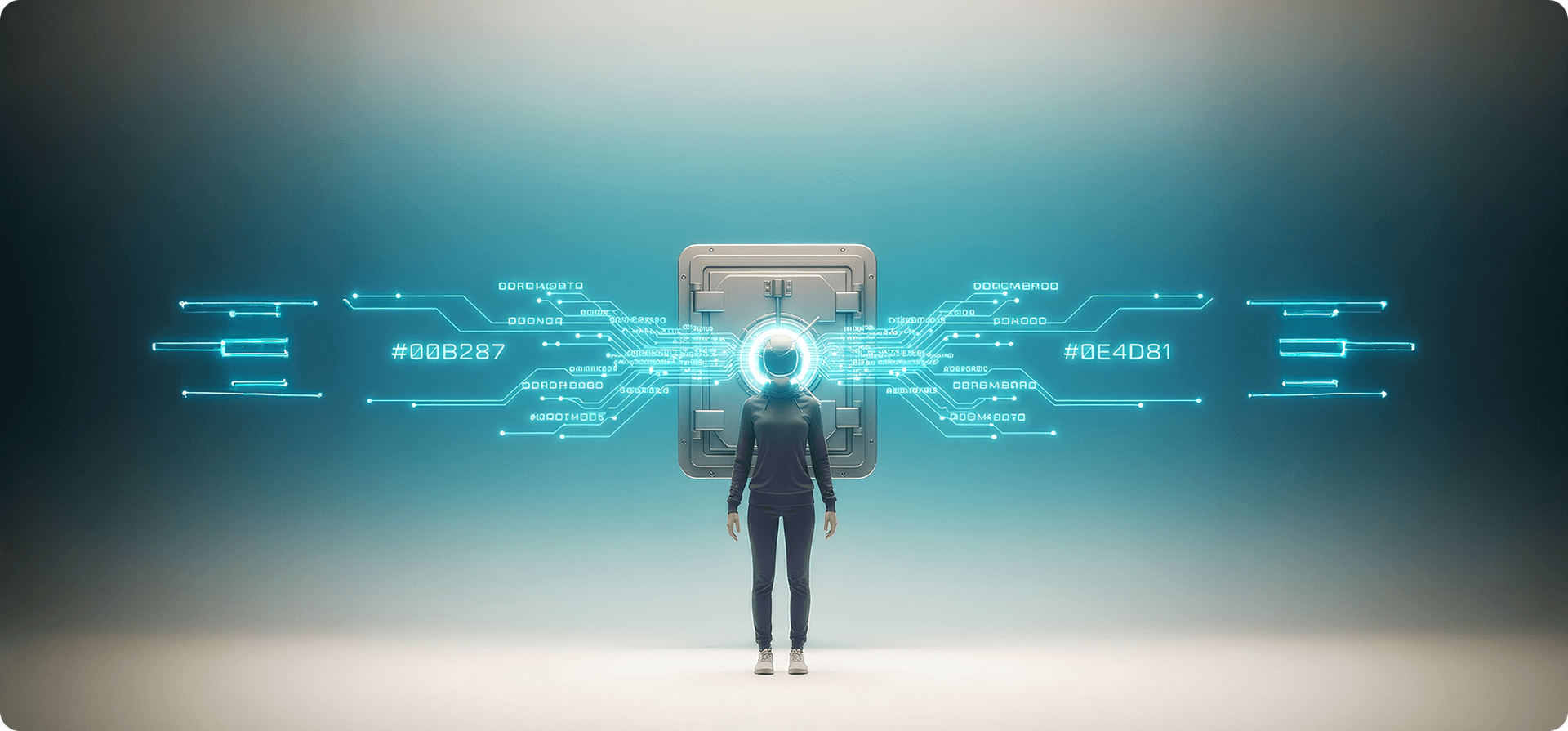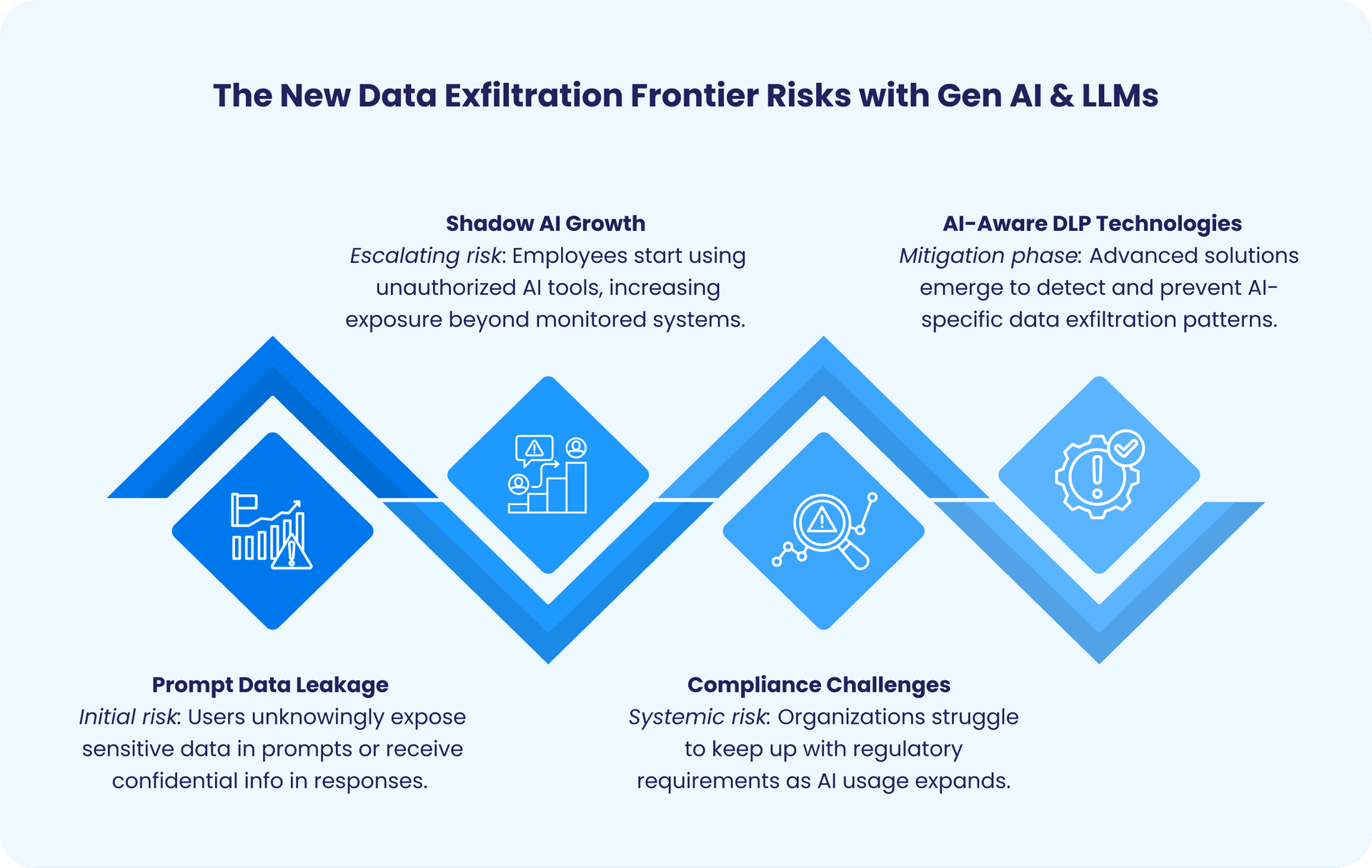


As enterprises integrate Generative AI (GenAI) and Large Language Models (LLMs) into core workflows, the risk of data exfiltration has evolved from a theoretical threat to an operational reality. Sensitive prompts, proprietary datasets, and contextual embeddings can be unintentionally exposed through model queries, integrations, or plugin ecosystems.
Traditional Data Loss Prevention (DLP) solutions, designed for structured data and static channels, fall short in safeguarding dynamic AI pipelines. In 2025, securing LLM ecosystems requires a context-aware DLP strategy built around model governance, Zero-Trust architecture, and continuous data lineage tracking.
This article explores how CISOs, IT Security leaders, and Compliance teams can adopt AI-specific DLP strategies that go beyond generic controls to protect sensitive data and intellectual property from leakage through AI systems.
Generative AI models are designed to generate human-like text by predicting output based on input prompts and learned data patterns. However, this ability also creates unique vectors for data leakage:
In 2024, Tenable researchers discovered critical privilege escalation vulnerabilities in Microsoft’s Azure Health Bot service, an AI-powered healthcare chatbot platform. These flaws allowed attackers to bypass protections and gain unauthorized access, potentially exposing sensitive patient data and resulting in HIPAA violations. This incident highlights the real-world risk of AI-powered chatbots leaking sensitive healthcare data when prompt handling and data interfaces lack proper security hardening.

A growing and often overlooked risk in AI data security is the phenomenon of Shadow AI, where employees use external AI tools like ChatGPT to process company data without formal approval or policy controls in place.
Unlike sanctioned IT systems, these tools often reside outside monitored and secured environments, creating significant blind spots for security teams:
Managing Shadow AI requires policies and technologies that extend DLP protections to these unsanctioned AI interactions, balancing innovation, productivity, and regulatory assurance.
Take our quick self-assessment to uncover hidden risks and get a checklist to guide your defenses against AI-powered data threats.
Conventional DLP systems rely on static, rule-based detection methods scanning files, data streams, and keyword matches. They are effective for structured data but blind to contextual meaning.
A healthcare provider in the U.S. faced a substantial fine under HIPAA regulations after sensitive patient data was accidentally leaked via AI chatbot interactions used in patient communications, illustrating the regulatory risks of generative AI.
Hence, DLP must evolve to integrate:
Regulatory frameworks intensify the need for advanced DLP in generative AI environments:
Meeting these compliance needs means embedding AI-aware controls directly within DLP frameworks, ensuring that AI-driven data flows are both visible and enforceable under legal standards.
To counter AI-driven exfiltration, DLP must evolve into a dynamic, AI-native framework. This means shifting from reactive scanning to proactive intervention at the prompt and token levels.

Prompt scrubbing involves inspecting and sanitizing inputs before they reach the LLM. Unlike basic redaction, which blacks out text, AI-aware scrubbing uses natural language processing (NLP) to identify and replace sensitive entities contextually. For example, tools can detect PII via named entity recognition (NER) and substitute with placeholders like "[CUSTOMER_ID]" while preserving query intent.
AI Multiple outlines 12 LLM DLP best practices, emphasizing automated redaction and masking techniques to anonymize data on-the-fly. Cloudflare's AI Prompt Protection employs a multi-model DLP engine to classify prompts by topic, blocking or scrubbing high-risk ones—such as those involving financials or health data—before transmission. This prevents leaks at the source, ensuring compliance without halting workflows.
Tokens, the building blocks of LLM inputs and outputs, must be logged and audited granularly. Traditional logs capture full messages; AI DLP extends this to token streams, tracking how data fragments traverse the model. This enables forensic analysis, for example, determining whether a prompt token containing “SSN” influenced an output. Advanced DLP solutions can integrate token-level inspection to flag anomalies in real time.
Audit trails also support retention limits, automatically purging logs after defined periods to align with "right to be forgotten" mandates. It is recommended to scrub data from prompts, knowledge bases, and fine-tuning sets upon user requests, creating a verifiable privacy trail. Microsoft Purview modernizes DLP for AI by correlating token events across endpoints and clouds, providing dashboards for CISOs to monitor usage patterns.
When deploying custom LLMs, fine-tune with retention-aware techniques: train on anonymized datasets and embed guardrails such as refusal prompts for sensitive queries. It is essential to prevent token leakage during fine-tuning by validating datasets for PII and enforcing differential privacy.
Combine this with access controls: role-based policies limit who can prompt certain models, while device controls block uploads to shadow tools. AI-driven data loss prevention (DLP) best practices emphasize streamlined enforcement and reduced false positives through machine learning.
Start with an AI usage policy: Define acceptable prompts, train employees, and deploy endpoint agents for browser interception. Concentric AI's 2025 DLP guide urges rethinking security for unstructured flows, integrating with SIEM for unified alerts. This evolution transforms DLP from a perimeter tool to an intelligent layer, offering the visibility your team craves.
AI brings transformative opportunities but also profound data security challenges, especially around data exfiltration risks posed by generative models and LLMs. Regulatory mandates under GDPR, HIPAA, and IP protection frameworks demand purpose-built DLP mechanisms that grasp AI-specific nuances like prompt data flows, token logging, and Shadow AI threats.
Enterprise security and compliance teams must evolve their DLP programs from reactive, rules-based frameworks into proactive, AI-aware defense systems. Technologies such as prompt scrubbing, advanced auditing, and fine-grained retention control are crucial to safeguarding sensitive data while unleashing AI’s potential.
For CISOs and IT security leaders, partnering with specialized AI-DLP, connecting with professionals, like our xSecurity team, can provide a strategic edge, empowering organizations to stay compliant, maintain data governance, and confidently harness generative AI innovation.

Contact us for an environment simulation and risk analysis. We provide a customized AI-DLP approach to protect your busine

Farrukh is the brain behind our cloud infrastructure security. He loves designing robust frameworks, adapting to emerging threats, and making sure everything runs smoothly without a hitch.
Tomorrow's Tech & Leadership Insights in
Your Inbox

4 Ways AI is Making Inroad in the Transportation Industry

Your Guide to Agentic AI: Technical Architecture and Implementation

5+ Examples of Generative AI in Finance

Knowledge Hub